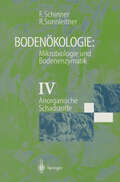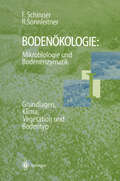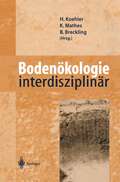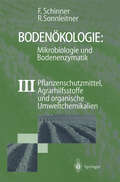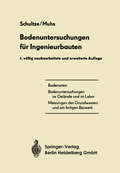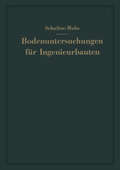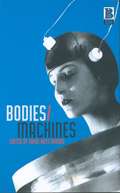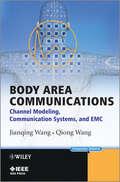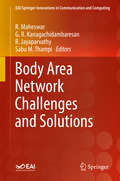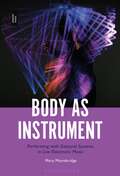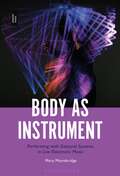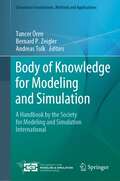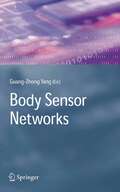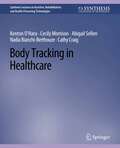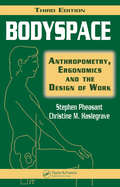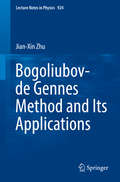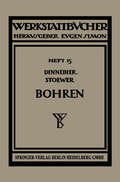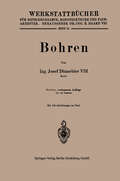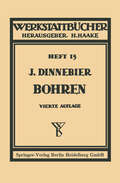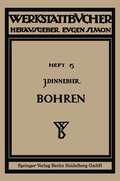- Table View
- List View
Bodenökologie interdisziplinär
by Hartmut Koehler Karin Mathes Broder BrecklingMit diesem Buch sollen aktuelle Entwicklungen der Bodenökologie einem breiteren Publikum zugänglich gemacht und Anknüpfungen zu deren Anwendungsfeldern hergestellt werden. Damit wird ein integrierter Überblick zu bodenökologischer Forschung und Praxis geliefert. Die Autoren stellen ökosystemare und interdisziplinäre Bezüge in den Vordergrund. Hierdurch lassen sich Anknüpfungen zu den lebensweltlichen Aufgabenstellungen und deren Lösungen aus der Perspektive konkreter Berufssituationen herstellen. Das Buch setzt zwar eine gewisse naturwissenschaftliche Vorbildung voraus, ist aber so verfaßt, daß seine Inhalte sowohl von Praktikern als auch Wissenschaftlern anderer Disziplinen nachvollzogen werden können. Eine enge Anbindung an einen fachspezifischen Ausbildungsstand ist nicht gegeben. Erfahrungsberichte aus der Berufspraxis von Bodenökologen runden den Inhalt ab.
Bodenökologie: Pflanzenschutzmittel, Agrarhilfsstoffe und organische Umweltchemikalien
by Franz Schinner Renate SonnleitnerBodenuntersuchungen für Ingenieurbauten
by Edgar Schultze Heinz MuhsWenn die Verfasser im Gegensatz zu früheren Arbeiten über bodenmecha nische Voruntersuchungen die Messungen in den Vordergrund ihrer Betrachtungen gestellt haben, so deshalb, weil die Entwicklung der Bodenmechanik zu einem großen Teil eine Sache der Theorie gewesen ist und in Spezialarbeiten zu einem mathematischen Aufwand geführt hat, der oft über die Bedürfnisse der Praxis hinausgeht, aber trotz allem nicht zu zuverlässigen Ergebnissen geführt hat. Die Bodenmechanik befindet sich heute an einem Punkt, wo eher durch Messungen ein Fortschritt erwartet werden kann. Der bisherige Bestand muß an Hand der Beobachtungen beim Versuch oder am fertigen Bauwerk überprüft und eine Auslese unter den theoretischen Überlegungen getroffen werden, deren Wert heute noch unentschieden ist. Das bedingt, daß nicht nur gemessen wird, sondern auch, daß die Versuchs und Meßergebnisse nicht als totes Kapitel, das nur für einen eng begrenzten Zweck verwendet wird, betrachtet, sondern systematisch ausgewertet werden. Bei der Behandlung eines so umfangreichen Zahlenmaterials, wie es bei den Vorunter suchungen des Grundbaus anfällt, kommt man ohne statistische Forschungs verfahren nicht aus. Einer derartigen Bearbeitung stehen allerdings gerade beim Untergrund verschiedene Hindernisse entgegen, vor allem die Tatsache, daß sich die Zusammensetzung und Beschaffenheit des Bodens nicht durch eine einfache Zahl wiedergeben läßt, außerdem aber die Abhängigkeit der ermittelten Kenn ziffern von den verschiedensten Veränderlichen. Dadurch bleiben Versuchsergeb nisse, die mit verschiedenen Apparaten und auf verschiedenen Baustellen oder in verschiedenen Anstalten gewonnen wurden, unvergleichbar.
Bodies/Machines
by Iwan Rhys MorusIt is hard to believe that the pursuit of artificial intelligence is not a phenomenon of the twentieth century. For over three hundred years, the boundaries between bodies and machines the natural and the artificial, the animate and the inanimate have been passionately explored. These explorations, beginning in the seventeenth and eighteenth and increasing during the nineteenth century, have been all but forgotten, lost beneath the commotion of the modern day world. This book retrieves these lost histories, giving voice to the hopes, dreams, and fears of philosophers, medical practitioners, engineers, craftsmen and artisans who have all been fascinated by the interface between bodies and machines. The journey back in time unfolds with the mysterious advent of mechanical philosophies, which conceptualized the body and the surrounding world largely in terms of mechanistic interactions. These theories develop in intriguing directions and fuel experiments in such areas as material production and social punishment, spiritualism and mental health. From reanimating dead bodies with electricity, which led to the introduction of the electric chair, through to the use of machines to render hysterics and the insane fit for reintroduction into society, this book conveys the dark truths behind our relationship with machines. This book is not only an exceptional contribution to the history of technology but also to contemporary debates about humans and machines.
Body Area Communications: Channel Modeling, Communication Systems, and EMC (Wiley - IEEE)
by Jianqing Wang Qiong WangProviding an introduction to the fundamentals of body area communications, this book covers the key topics of channel modeling, modulation and demodulation, and performance evaluation A systematic introduction to body area networks (BAN), this book focuses on three major parts: channel modeling, modulation/demodulation communications performance, and electromagnetic compatibility considerations. The content is logically structured to lead readers from an introductory level through to in-depth and more advanced topics. Provides a concise introduction to this emerging topic based on classroom-tested materials Details the latest IEEE 802.15.6 standard activities Moves from very basic physics, to useful mathematic models, and then to practical considerations Covers not only EM physics and communications, but also biological applications Topics approached include: link budget, bit error rate performance, RAKE and diversity reception; SAR analysis for human safety evaluation; and modeling of electromagnetic interference to implanted cardiac pacemakers Provides Matlab and Fortran programs for download from the Companion Website
Body Area Communications: Channel Modeling, Communication Systems, and EMC (Wiley - IEEE)
by Jianqing Wang Qiong WangProviding an introduction to the fundamentals of body area communications, this book covers the key topics of channel modeling, modulation and demodulation, and performance evaluation A systematic introduction to body area networks (BAN), this book focuses on three major parts: channel modeling, modulation/demodulation communications performance, and electromagnetic compatibility considerations. The content is logically structured to lead readers from an introductory level through to in-depth and more advanced topics. Provides a concise introduction to this emerging topic based on classroom-tested materials Details the latest IEEE 802.15.6 standard activities Moves from very basic physics, to useful mathematic models, and then to practical considerations Covers not only EM physics and communications, but also biological applications Topics approached include: link budget, bit error rate performance, RAKE and diversity reception; SAR analysis for human safety evaluation; and modeling of electromagnetic interference to implanted cardiac pacemakers Provides Matlab and Fortran programs for download from the Companion Website
Body Area Network Challenges and Solutions (EAI/Springer Innovations in Communication and Computing)
by R. Maheswar G. R. Kanagachidambaresan R. Jayaparvathy Sabu M. ThampiThis book provides a novel solution for existing challenges in wireless body sensor networks (WBAN) such as network lifetime, fault tolerant approaches, reliability, security, and privacy. The contributors first discuss emerging trends of WBAN in the present health care system. They then provide possible solutions to challenges inherent in WBANs. Finally, they discuss results in working environments. Topics include communication protocols of implanted, wearable and nano body sensor networks; energy harvesting methodologies and experimentation for WBAN; reliability analysis and fault tolerant architecture for WBAN; and handling network failure during critical duration. The contributors consist of researchers and practitioners in WBAN around the world.
Body as Instrument: Performing with Gestural Systems in Live Electronic Music
by Mary MainsbridgeBody as Instrument explores how musicians interact with movement-controlled performance systems, producing sounds imbued with their individual physical signature. Using motion tracking technology, performers can translate physical actions into sonic processes, creating or adapting novel gestural systems that transcend the structures and constraints of conventional musical instruments. Interviews with influential artists in the field, Laetitia Sonami, Atau Tanaka, Pamela Z, Julie Wilson-Bokowiec, Lauren Sarah Hayes, Mark Coniglio, Garth Paine and The Bent Leather Band expose the transformational impact of motion sensors on musicians' body awareness and abilities. Coupled with reflection on author-composed works, the book analyses how the body as instrument metaphor informs relationships between performers, their bodies and self-designed instruments. It also examines the role of experiential design strategies in developing robust and nuanced gestural systems that mirror a performer's movement habits, preferences and skills, inspiring new physical forms of musical communication and diverse musical repertoire.
Body as Instrument: Performing with Gestural Systems in Live Electronic Music
by Mary MainsbridgeBody as Instrument explores how musicians interact with movement-controlled performance systems, producing sounds imbued with their individual physical signature. Using motion tracking technology, performers can translate physical actions into sonic processes, creating or adapting novel gestural systems that transcend the structures and constraints of conventional musical instruments. Interviews with influential artists in the field, Laetitia Sonami, Atau Tanaka, Pamela Z, Julie Wilson-Bokowiec, Lauren Sarah Hayes, Mark Coniglio, Garth Paine and The Bent Leather Band expose the transformational impact of motion sensors on musicians' body awareness and abilities. Coupled with reflection on author-composed works, the book analyses how the body as instrument metaphor informs relationships between performers, their bodies and self-designed instruments. It also examines the role of experiential design strategies in developing robust and nuanced gestural systems that mirror a performer's movement habits, preferences and skills, inspiring new physical forms of musical communication and diverse musical repertoire.
Body of Knowledge for Modeling and Simulation: A Handbook by the Society for Modeling and Simulation International (Simulation Foundations, Methods and Applications)
by Tuncer Ören Bernard P. Zeigler Andreas TolkCommissioned by the Society for Modeling and Simulation International (SCS), this needed, useful new ‘Body of Knowledge’ (BoK) collects and organizes the common understanding of a wide collection of professionals and professional associations.Modeling and simulation (M&S) is a ubiquitous discipline that lays the computational foundation for real and virtual experimentation, clearly stating boundaries—and interactions—of systems, data, and representations. The field is well known, too, for its training support via simulations and simulators. Indeed, with computers increasingly influencing the activities of today’s world, M&S is the third pillar of scientific understanding, taking its place along with theory building and empirical observation.This valuable new handbook provides intellectual support for all disciplines in analysis, design and optimization. It contributes increasingly to the growing number of computational disciplines, addressing the broad variety of contributing as well as supported disciplines and application domains. Further, each of its sections provide numerous references for further information. Highly comprehensive, the BoK represents many viewpoints and facets, captured under such topics as:Mathematical and Systems Theory FoundationsSimulation Formalisms and ParadigmsSynergies with Systems Engineering and Artificial IntelligenceMultidisciplinary ChallengesEthics and PhilosophyHistorical PerspectivesExamining theoretical as well as practical challenges, this unique volume addresses the many facets of M&S for scholars, students, and practitioners. As such, it affords readers from all science, engineering, and arts disciplines a comprehensive and concise representation of concepts, terms, and activities needed to explain the M&S discipline.Tuncer Ören is Professor Emeritus at the University of Ottawa. Bernard Zeigler is Professor Emeritus at the University of Arizona. Andreas Tolk is Chief Scientist at The MITRE Corporation. All three editors are long-time members and Fellows of the Society for Modeling and Simulation International. Under the leadership of three SCS Fellows, Dr. Ören, University of Ottawa, Dr. Zeigler, The University of Arizona, and Dr. Tolk, The MITRE Corporation, more than 50 international scholars from 15 countries provided insights and experience to compile this initial M&S Body of Knowledge.
Body Sensor Networking, Design and Algorithms
by Saeid Sanei Delaram Jarchi Anthony G. ConstantinidesA complete guide to the state of the art theoretical and manufacturing developments of body sensor network, design, and algorithms In Body Sensor Networking, Design, and Algorithms, professionals in the field of Biomedical Engineering and e-health get an in-depth look at advancements, changes, and developments. When it comes to advances in the industry, the text looks at cooperative networks, noninvasive and implantable sensor microelectronics, wireless sensor networks, platforms, and optimization—to name a few. Each chapter provides essential information needed to understand the current landscape of technology and mechanical developments. It covers subjects including Physiological Sensors, Sleep Stage Classification, Contactless Monitoring, and much more. Among the many topics covered, the text also includes additions such as: ● Over 120 figures, charts, and tables to assist with the understanding of complex topics ● Design examples and detailed experimental works ● A companion website featuring MATLAB and selected data sets Additionally, readers will learn about wearable and implantable devices, invasive and noninvasive monitoring, biocompatibility, and the tools and platforms for long-term, low-power deployment of wireless communications. It’s an essential resource for understanding the applications and practical implementation of BSN when it comes to elderly care, how to manage patients with chronic illnesses and diseases, and use cases for rehabilitation.
Body Sensor Networking, Design and Algorithms
by Saeid Sanei Delaram Jarchi Anthony G. ConstantinidesA complete guide to the state of the art theoretical and manufacturing developments of body sensor network, design, and algorithms In Body Sensor Networking, Design, and Algorithms, professionals in the field of Biomedical Engineering and e-health get an in-depth look at advancements, changes, and developments. When it comes to advances in the industry, the text looks at cooperative networks, noninvasive and implantable sensor microelectronics, wireless sensor networks, platforms, and optimization—to name a few. Each chapter provides essential information needed to understand the current landscape of technology and mechanical developments. It covers subjects including Physiological Sensors, Sleep Stage Classification, Contactless Monitoring, and much more. Among the many topics covered, the text also includes additions such as: ● Over 120 figures, charts, and tables to assist with the understanding of complex topics ● Design examples and detailed experimental works ● A companion website featuring MATLAB and selected data sets Additionally, readers will learn about wearable and implantable devices, invasive and noninvasive monitoring, biocompatibility, and the tools and platforms for long-term, low-power deployment of wireless communications. It’s an essential resource for understanding the applications and practical implementation of BSN when it comes to elderly care, how to manage patients with chronic illnesses and diseases, and use cases for rehabilitation.
Body Sensor Networks
by M. Yacoub Guang-Zhong YangThis book addresses the issues of the rapidly changing field of wireless wearable and implantable sensors. It also discusses the latest technological developments and clinical applications of body-sensor networks (BSN). BSN is a new area of research and the last decade has seen a rapid surge of interest. The book also provides a review of current wireless sensor development platforms and a guide to developing your own BSN applications.
Body Sensors and Electrocardiography (SpringerBriefs in Applied Sciences and Technology)
by Roman Trobec Ivan Tomašić Aleksandra Rashkovska Matjaž Depolli Viktor AvbeljThis monograph presents a comprehensive overview of the electrocardiography from the aspect of wireless and mobile monitoring and its potential for personalized health management. The topical focus is on the implementation and efficient application of user friendly m-Health systems. The target audience comprises biomedical engineers, medical doctors, students, industrial experts and health managers developing m-Health solutions.
Body Tracking in Healthcare (Synthesis Lectures on Assistive, Rehabilitative, and Health-Preserving Technologies)
by Kenton O'Hara Cecily Morrison Abigail Sellen Nadia Bianchi-Berthouze Cathy CraigWithin the context of healthcare, there has been a long-standing interest in understanding the posture and movement of the human body. Gait analysis work over the years has looked to articulate the patterns and parameters of this movement both for a normal healthy body and in a range of movement-based disorders. In recent years, these efforts to understand the moving body have been transformed by significant advances in sensing technologies and computational analysis techniques all offering new ways for the moving body to be tracked, measured, and interpreted. While much of this work has been largely research focused, as the field matures, we are seeing more shifts into clinical practice. As a consequence, there is an increasing need to understand these sensing technologies over and above the specific capabilities to track, measure, and infer patterns of movement in themselves. Rather, there is an imperative to understand how the material form of these technologies enables them also to be situated in everyday healthcare contexts and practices. There are significant mutually interdependent ties between the fundamental characteristics and assumptions of these technologies and the configurations of everyday collaborative practices that are possible them. Our attention then must look to social, clinical, and technical relations pertaining to these various body technologies that may play out in particular ways across a range of different healthcare contexts and stakeholders. Our aim in this book is to explore these issues with key examples illustrating how social contexts of use relate to the properties and assumptions bound up in particular choices of body-tracking technology. We do this through a focus on three core application areas in healthcare—assessment, rehabilitation, and surgical interaction—and recent efforts to apply body-tracking technologies to them.
Bodyspace: Anthropometry, Ergonomics and the Design of Work, Third Edition
by Stephen Pheasant Christine M. HaslegraveIn the 20 years since the publication of the first edition of Bodyspace the knowledge base upon which ergonomics rests has increased significantly. The need for an authoritative, contemporary and, above all, usable reference is therefore great. This third edition maintains the same content and structure as previous editions, but updates the material and references to reflect recent developments in the field. The book has been substantially revised to include new research and anthropometric surveys, the latest techniques, and changes in legislation that have taken place in recent years. New coverage in the third edition: Guidance on design strategies and practical advice on conducting trials Overview of recent advances in simulation and digital human modes Dynamic seating · Recent work on hand/handle interface Computer input devices · Laptop computer use and children’s use of computers · Design for an aging population and accessibility for people with disabilities · New approaches to risk management and new assessment tools, legislation, and standards As the previous two editions have shown, Bodyspace is an example of the unusual: a text that is a favorite among academics and practitioners. Losing none of the features that made previous editions so popular, the author skillfully integrates new knowledge into the existing text without sacrificing the easily accessible style that makes this book unique. More than just a reference text, this authoritative book clearly delineates the field of ergonomics.
Bodyspace: Anthropometry, Ergonomics and the Design of Work, Third Edition
by Stephen Pheasant Christine M. HaslegraveIn the 20 years since the publication of the first edition of Bodyspace the knowledge base upon which ergonomics rests has increased significantly. The need for an authoritative, contemporary and, above all, usable reference is therefore great. This third edition maintains the same content and structure as previous editions, but updates the material and references to reflect recent developments in the field. The book has been substantially revised to include new research and anthropometric surveys, the latest techniques, and changes in legislation that have taken place in recent years. New coverage in the third edition: Guidance on design strategies and practical advice on conducting trials Overview of recent advances in simulation and digital human modes Dynamic seating · Recent work on hand/handle interface Computer input devices · Laptop computer use and children’s use of computers · Design for an aging population and accessibility for people with disabilities · New approaches to risk management and new assessment tools, legislation, and standards As the previous two editions have shown, Bodyspace is an example of the unusual: a text that is a favorite among academics and practitioners. Losing none of the features that made previous editions so popular, the author skillfully integrates new knowledge into the existing text without sacrificing the easily accessible style that makes this book unique. More than just a reference text, this authoritative book clearly delineates the field of ergonomics.
Bogoliubov-de Gennes Method and Its Applications (Lecture Notes in Physics #924)
by Jian-Xin ZhuThe purpose of this book is to provide an elementary yet systematic description of the Bogoliubov-de Gennes (BdG) equations, their unique symmetry properties and their relation to Green’s function theory. Specifically, it introduces readers to the supercell technique for the solutions of the BdG equations, as well as other related techniques for more rapidly solving the equations in practical applications.The BdG equations are derived from a microscopic model Hamiltonian with an effective pairing interaction and fully capture the local electronic structure through self-consistent solutions via exact diagonalization. This approach has been successfully generalized to study many aspects of conventional and unconventional superconductors with inhomogeneities – including defects, disorder or the presence of a magnetic field – and becomes an even more attractive choice when the first-principles information of a typical superconductor is incorporated via the construction of a low-energy tight-binding model. Further, the lattice BdG approach is essential when theoretical results for local electronic states around such defects are compared with the scanning tunneling microscopy measurements.Altogether, these lectures provide a timely primer for graduate students and non-specialist researchers, while also offering a useful reference guide for experts in the field.
Bohren (Werkstattbücher #15)
by J. Dinnebier H. J. StoewerDieser Buchtitel ist Teil des Digitalisierungsprojekts Springer Book Archives mit Publikationen, die seit den Anfängen des Verlags von 1842 erschienen sind. Der Verlag stellt mit diesem Archiv Quellen für die historische wie auch die disziplingeschichtliche Forschung zur Verfügung, die jeweils im historischen Kontext betrachtet werden müssen. Dieser Titel erschien in der Zeit vor 1945 und wird daher in seiner zeittypischen politisch-ideologischen Ausrichtung vom Verlag nicht beworben.
Bohren (Werkstattbücher #15 )
by Josef DinnebierDieser Buchtitel ist Teil des Digitalisierungsprojekts Springer Book Archives mit Publikationen, die seit den Anfängen des Verlags von 1842 erschienen sind. Der Verlag stellt mit diesem Archiv Quellen für die historische wie auch die disziplingeschichtliche Forschung zur Verfügung, die jeweils im historischen Kontext betrachtet werden müssen. Dieser Titel erschien in der Zeit vor 1945 und wird daher in seiner zeittypischen politisch-ideologischen Ausrichtung vom Verlag nicht beworben.
Bohren (Werkstattbücher #15 )
by Josef DinnebierDieser Buchtitel ist Teil des Digitalisierungsprojekts Springer Book Archives mit Publikationen, die seit den Anfängen des Verlags von 1842 erschienen sind. Der Verlag stellt mit diesem Archiv Quellen für die historische wie auch die disziplingeschichtliche Forschung zur Verfügung, die jeweils im historischen Kontext betrachtet werden müssen. Dieser Titel erschien in der Zeit vor 1945 und wird daher in seiner zeittypischen politisch-ideologischen Ausrichtung vom Verlag nicht beworben.
